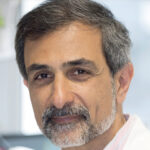Présentation
We use a number of genetically modified mice to interrogate specific functions of stem/progenitor cells during the establishment of muscle and its reconstitution after injury. These include mutants for Myf5, Pax7, Myod, Tbx1, RBPJk, Numb, Numblike, Notchless, in combination with Cre drivers and fluorescent reporter mice. We also isolate and characterise mouse and human stem cells and examine their function in reconstitution assays by transplantations into injured dystrophic or normal muscles. We generated a genetic model where muscle satellite cells are eliminated by administration of dihptheria toxin (collaboration, Dr. Anne Galy). Notably, elimination of satellite cells results in failed regeneration indicating that other stem cells in muscle require satellite cells; failed regeneration was rescued by transplantion of satellite cells in this model (8). In other studies, we showed that the majority of quiescent satellite cells express Myf5 protein, and resident Myf5 heterozygous muscle stem cells are more primed for myogenic commitment compared to wild type satellite cells indicating that Myf5 protein in quiescent satellite cells maintains their stem cell state. Paradoxically however, heterotypic transplantation of Myf5 heterozygous cells into regenerating muscles results in higher self-renewal capacity compared to wild-type stem cells (9). These findings show that endogenous and transplanted muscle satellite cells can exhibit distinct phenotypes. They also have important implications for how stem cell fates can be modulated by critical transcription factors while generating a pool of responsive heterogeneous cells. The above mentioned studies are complemented with developmental microarrays and miRNA screens that have been done using genetically modified mice to identify novel regulators of muscle stem cell fate. For example, to identify regulators of Notch signaling, we performed the first specific RBPJ chromatin immunoprecipitation and high-throughput sequencing study in mammalian cells under active or inhibitory Notch signaling conditions. Whole-genome binding profiles were generated for RBPJ, its coactivator, p300, NICD, and H3K4me3, H3K4me1, and H3K27ac (collaboration, Dr. Henk Stunnenberg, 10). Our results demonstrate dynamic binding of RBPJ in response to Notch activation at essentially all sites co-occupied by NICD. Additionally, we identify a distinct set of sites where RBPJ recruits neither NICD nor p300 and binds DNA statically, irrespective of Notch activity. These findings significantly modify our views on how RBPJ and Notch signaling mediate their activities and consequently impact on cell fate decisions. The projects outlined here should provide a link between the normal development of a tissue, its deregulation during disease, and its regeneration via the recruitment of stem and progenitor cells.

